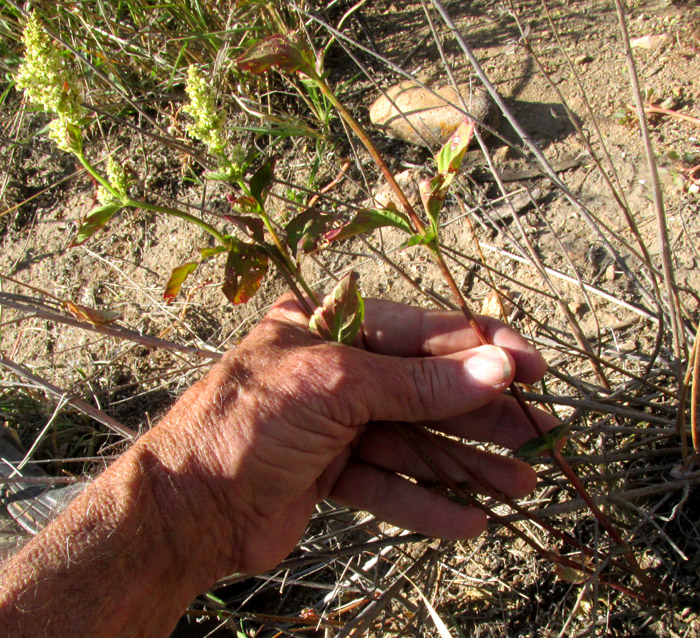Excerpts from Jim Conrad's
Naturalist Newsletter
Entry dated February 3, 2024, issued from near Tequisquiapan; elevation about 1,900m, (6200 ft), ~N20.57°, ~W99.89°; Querétaro state, MÉXICO
LAMBSQUARTERS

The above drought-stunted, scraggly weed somehow managed to flower while rooted in dusty sediment at the foot of the volcanic rock outcrop profiled on our brecciated tuff page. Currently we're experiencing the normal dry season during a continuing two-year drought which the North American Drought Monitor designates as a D3 Extreme Drought. Our plant was definitely a drought resistant one meriting attention on a planet rushing toward desertification.

Numerous individual tiny flowers crowded on short branches of the inflorescence's main axis, the rachis. The main inflorescence terminated the stem's tip, but other smaller ones issued from the axils of leaves lower down.

Up close, things looked messy and overcrowded, though probably the compactness greatly reduced water loss through evaporation, by limiting exposed surface area. A little above the above picture's lower, left corner a flower is seen from the side. It's crowned with five pale, membranous tepals, the term tepal used when calyx lobes are indistinguishable from corolla lobes or petals. Below the tepals the flower bulges with a developing, utricle-type fruit, a utricle being a fruit with seeds contained within a thin-skinned, bladderlike structure, the pericarp. Near the picture's center but a little to the right, an egg-shaped, green ovary peeps from among its tepals, topped by two pale, pollen-gathering stigmas. Certain green parts are heavily spotted with white "farina" -- mealy specks whose presence helps with the plant's identification.

The above leaf gradually diminishes toward its base. Sparse farina covers its surface, and reddish pigment develops along the blade's margins and around diseased spots. The pigment's "beet color" makes sense, since our plant is closely related to the cultivated beet; beet-plant flowers are fairly similar to those seen above. Both beet plants and our plant belong to the Amaranth Family, the Amaranthaceae.
On the family farm back in rural Kentucky I used to eat this species, liking a heap of it lightly cooked and topped with melting butter, and eaten with hot cornbread. However, the above scrawny plants' general appearance contrasts sharply with the lush, knee-tall plants in our well manured barnyard. Below, part of the reason for such a different look -- other than the manure -- is addressed.
Our plant, probably native to Europe but now invasive nearly worldwide, is CHENOPODIUM ALBUM, named by Linnaeus himself in 1753. Back in the 60s, I learned from books to call the plant Lambsquarters, but over the world it's known by any number of English names, including Goosefoot, Pigweed, Wild Spinach, Fat-hen, Melde, Mealweed, Bacon-weed, Frost-blite and more. During my Belgium years I used to call it Chénopode Blanc, and I ate it there, too.The Flora of North America expands beyond its usual dry technicality, saying that this species is one of the worst weeds and most widespread synanthropic plants on the Earth plus. "Synanthropic" describes an undomesticated organism that nonetheless lives in close association with humans, and benefits from human surroundings and activities. English Sparrows, Pigeons and Lambsquarters are classic synanthropes.
The Flora also speaks of its use of a broad circumscription for the species, a concept lumping numerous variations of what the authors consider one of the Earth's most polymorphic plant species. Some authorities break the species into subspecies and other taxonomic units. However, with regard to the many variations, the Flora authors remark that "It is evident that most recent evolutionary processes within the group were greatly affected by anthropic factors, including extensive recent invasions, hybridization between previously geographically isolated taxa, polyploidy, intensive selective processes and mutagenesis in synanthropic habitats, gene drift, and so forth."
Among those variations is one sometimes named Chenopodium lanceolatum or C. album var. lanceolatum. The Flora authors regard the lanceolatum form as probably the most widespread and variable of many North American variations; I assume that such may be true for Mexico as well. The authors regard the typical Chenopodium album -- the one I grew up eating in Kentucky -- as growing erect on cultivated ground, while lanceolatum variations inhabit vacant lots, roadsides, and display a more sprawling habit -- like our plant pictured above. It grew leaning away from the base of a dried-up, larger, perennial herb.
Undoubtedly Lambsquarters is a serious weed in important rowcrops. However, also it has a long history as a nutritional food itself. Not only its leaves and flowers can be eaten as cooked greens, but also each plant can produce thousands of edible seeds. Quinoa, famous for its nutritional seeds, also is a Chenopodium. David Miles' 1987 An Introduction to Archaeology tells us that carbonized Lambsquarters remains have been found in Iron Age and Viking storage pits and ovens, and its seeds have been identified in stomachs of ancient Danish bog bodies. Nutritional analysis finds raw Lambsquarters to be 4% protein, with a 100 gram serving providing 96% of the human daily requirement of vitamin C, 73% of vitamin A, 37% of both riboflavin and manganese, and more.